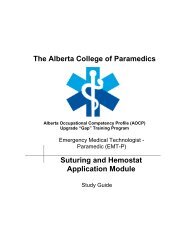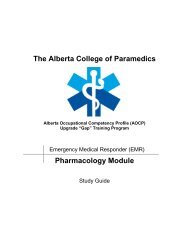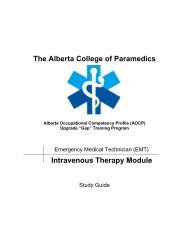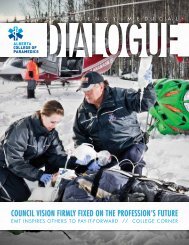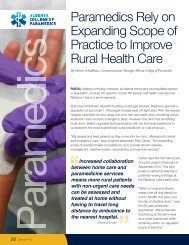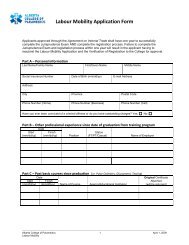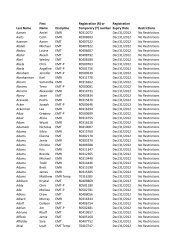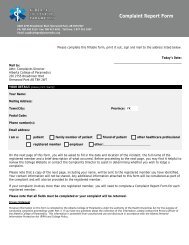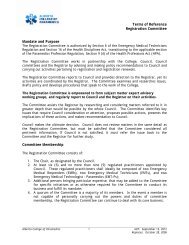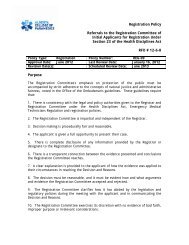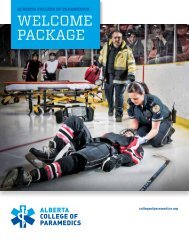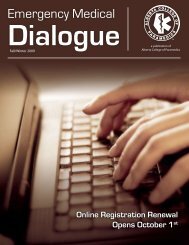Fall/Winter 2011 - Alberta College of Paramedics
Fall/Winter 2011 - Alberta College of Paramedics
Fall/Winter 2011 - Alberta College of Paramedics
Create successful ePaper yourself
Turn your PDF publications into a flip-book with our unique Google optimized e-Paper software.
emergency medical dialogue<br />
<strong>Paramedics</strong> rely on expanding scope <strong>of</strong><br />
practice to improve rural health care<br />
Paramedic Gary Fenton draws blood from patient Chloe Leptich at the Rainbow Lake Health Centre. | Photo credit: Maureen Leptich<br />
As rural population numbers continue<br />
to grow in many <strong>Alberta</strong> towns and<br />
municipalities, so does the need for crucial,<br />
life-saving rural healthcare services.<br />
Rainbow Lake is a prime example.<br />
Built around Northern <strong>Alberta</strong>’s<br />
bustling oil and gas industry, Rainbow<br />
Lake is a population <strong>of</strong> just under<br />
1,100 people located west <strong>of</strong> High<br />
Level. With the nearest hospital more<br />
than an hour away, the town has one<br />
health clinic consisting <strong>of</strong> four treatment<br />
rooms and two emergency beds.<br />
However, this particular clinic has<br />
something most others don’t have—<br />
skilled, regulated paramedics on staff<br />
who have the technical experience<br />
to complement the most experienced<br />
nurse practitioner or rural physician.<br />
“We assess and treat patients as they<br />
come into the clinic, <strong>of</strong>fering both clinical<br />
and emergency care,” says longtime<br />
paramedic Rick Cartier. “Our expanding<br />
scope <strong>of</strong> practice makes it possible for us<br />
to provide chronic disease management,<br />
treatment plans and lab services.”<br />
Cartier says his new role is part <strong>of</strong> a<br />
pilot project introduced in September<br />
2010, aimed at relieving a potential<br />
nursing shortage at the Rainbow Lake<br />
Health Centre.<br />
“When a nurse practitioner needs time<br />
<strong>of</strong>f and there’s no one to backfill, the<br />
clinic runs the risk <strong>of</strong> shutting down,”<br />
explains Cartier, who has nearly 20<br />
years <strong>of</strong> experience as a paramedic<br />
practitioner. “We’re basically<br />
functioning at the same level as a nurse<br />
practitioner while remaining within our<br />
regulated scope <strong>of</strong> practice.”<br />
In <strong>Alberta</strong>, paramedic practitioners must<br />
be registered with the <strong>Alberta</strong> <strong>College</strong><br />
<strong>of</strong> <strong>Paramedics</strong> to legally practice<br />
paramedicine, and are required to<br />
continually monitor and enhance their<br />
individual competencies within the<br />
pr<strong>of</strong>ession’s growing scope <strong>of</strong> practice.<br />
“Our expanding scope<br />
<strong>of</strong> practice makes it<br />
possible for us to<br />
provide chronic disease<br />
management, treatment<br />
plans and lab services.”<br />
– Rick Cartier, EMT-P.<br />
“Out here, I’d say we use about 90<br />
per cent <strong>of</strong> our scope <strong>of</strong> practice,”<br />
adds Cartier.<br />
Integrated<br />
health services<br />
Rainbow Lake is just one example <strong>of</strong><br />
evolutionary pre-hospital care in <strong>Alberta</strong>.<br />
<strong>Paramedics</strong> work in increasingly diverse<br />
settings including municipal ambulance<br />
services, fire and rescue departments,<br />
air ambulance services, hospitals, longterm<br />
care settings, ski hills, rodeos and<br />
industrial medical services such as oil<br />
field standbys.<br />
Carol Duncan is the integrated home<br />
care area manager based out <strong>of</strong> the<br />
Canmore Hospital.<br />
“From my perspective, the door is<br />
just beginning to open in the<br />
area <strong>of</strong> integrated pre-hospital<br />
care,” says Duncan. “Increased<br />
collaboration between home care<br />
and paramedicine services means<br />
more rural patients with non-urgent<br />
care needs can be assessed and<br />
treated at home without having to<br />
travel long distance by ambulance<br />
to the nearest hospital.”<br />
Rural hospital settings are also realizing<br />
the benefits <strong>of</strong> onsite paramedic services.<br />
In 2010, the Northwest Health<br />
Centre in High Level contracted<br />
two paramedics to assist nursing<br />
and medical staff in the emergency<br />
department. Proving to be quite<br />
successful, this project is expected to<br />
be introduced in a growing number <strong>of</strong><br />
rural hospital locations across <strong>Alberta</strong>.<br />
Paramedic Rick Cartier welcomes the shift.<br />
on the cover<br />
“It’s definitely made me a better<br />
practitioner,” says Cartier. “You can’t<br />
help but pick up a lot working alongside<br />
doctors and nurse practitioners in an<br />
active team environment. The shared<br />
knowledge is invaluable.”<br />
17<br />
<strong>Fall</strong>/<strong>Winter</strong> <strong>2011</strong> // www.college<strong>of</strong>paramedics.org




